Your handy raptor identification guide is back with a second installment – RAP201: How to Identify Uncommon Raptors! This article will cover seven species that migrate through Singapore in relatively low numbers: Grey-faced Buzzard (Butastur indicus), Common Buzzard (Buteo buteo), Eastern Buzzard (Buteo japonicus), Booted Eagle (Hieraaetus pennatus), Black Kite (Milvis migrans), Greater Spotted Eagle (Clanga clanga) and Besra (Accipiter virgatus).
Do check out RAP101: How to Identify Common Raptors to pick up tips on identifying common raptors and some background on raptor migration. As usual, we will be using the most mediocre of photos to show you do not need amazing gear for identification (though they undoubtedly come in handy for the trickier ones).
[Update 17/10/22: Bar charts from our migrant bar charts were added to highlight the peak periods for the migratory raptors listed here.]
Grey-faced Buzzard (Butastur indicus)
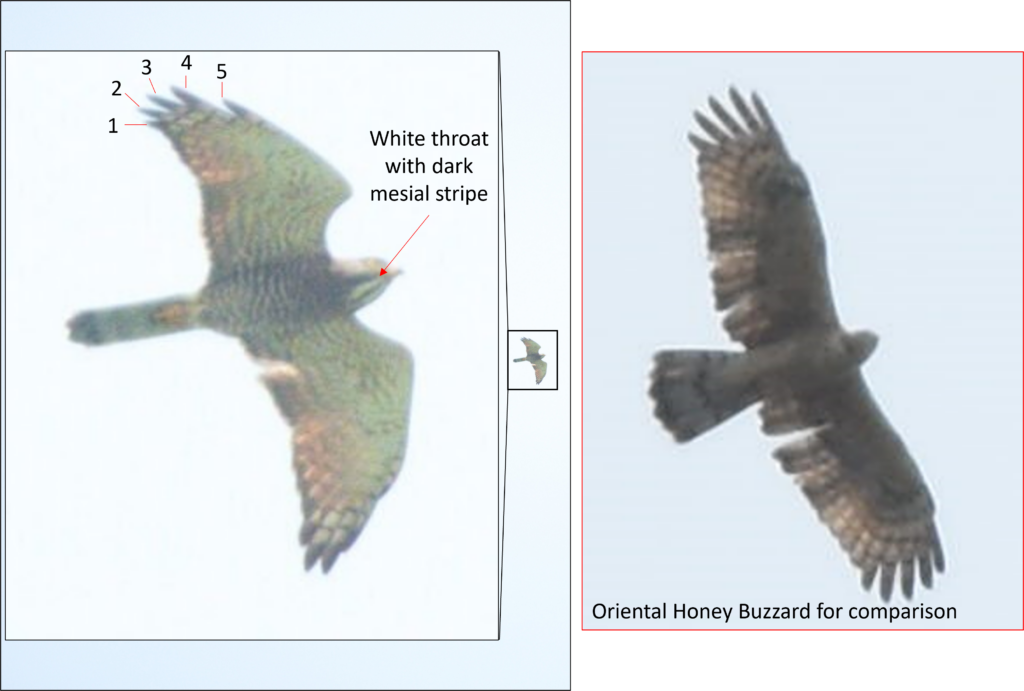
The Grey-faced Buzzard is a medium-sized migratory raptor. It has longer, slimmer wings than the Oriental Honey Buzzard (Pernis ptilorhynchus) when fully extended, with a white throat and dark mesial stripe. It also has five ‘fingers’ as opposed to the Oriental Honey Buzzard’s six ‘fingers’. In juveniles, that are similar in shape to adults, the mesial stripe are not as pronounced and they have streaks on their underparts instead of barrings.
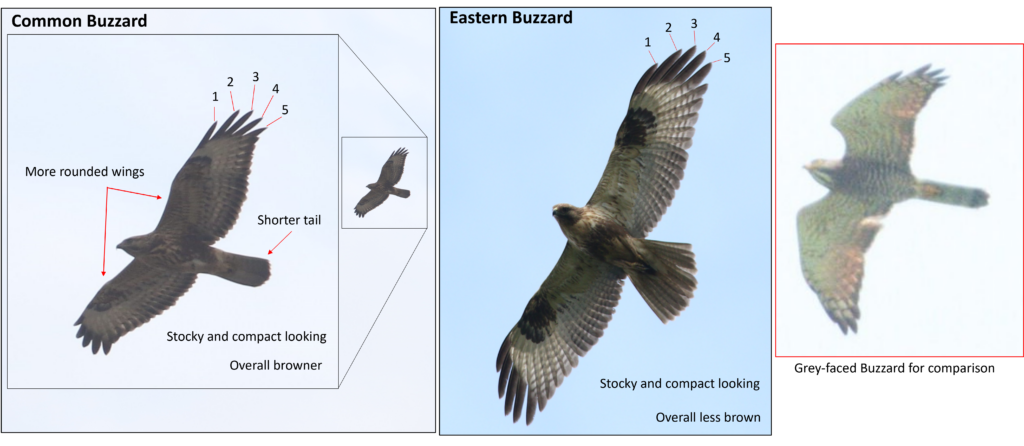
Buteo sp. refers to buzzards, that are stocky, medium-sized raptors with long wings ending in five ‘fingers’. They can be differentiated from Grey-faced Buzzards, which also have five ‘fingers’, by the lack of a mesial stripe, shorter tail, shorter and more rounded wings. Taxonomy of the Buzzards are contentious, with different ornithological authorities treating them differently – some consider the Common and Eastern Buzzards separate species while some recognize them as subspecies (Gill et al., 2021; Billerman et al., 2020; McClure et al., 2020). Common Buzzards (Buteo buteo) are browner overall compared to Eastern Buzzards (Buteo japonicus). Given the messy taxonomy it is currently unclear where exactly the Eastern Buzzards in Singapore arrive from.
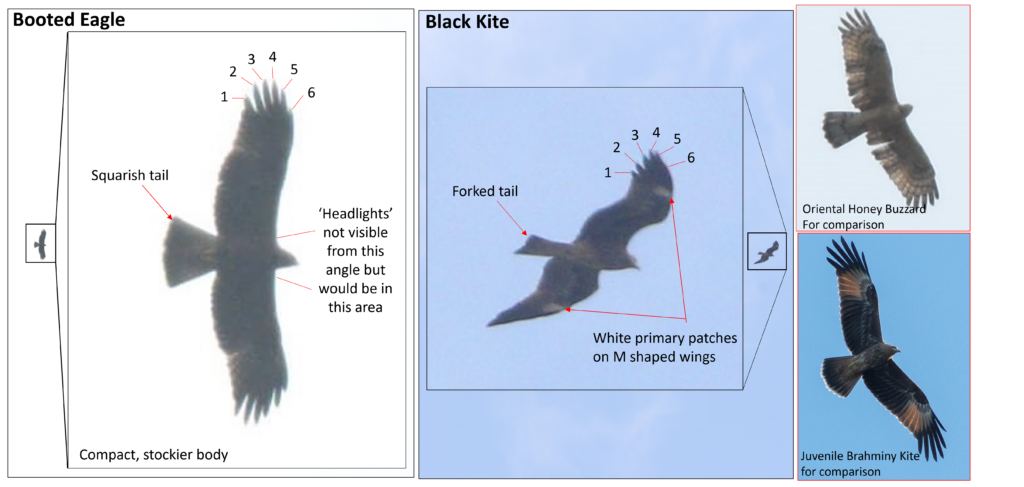
Booted Eagle (Hieraaetus pennatus)
The Booted Eagle has wings that are somewhat similar in shape to the locally common Brahminy Kites, with six ‘fingers’. It has pale shoulder spots on the upperwing, resembling ‘headlights’. Compared to the Oriental Honey Buzzard that also has six ‘fingers’, the Booted Eagle has a more compact, stockier giss and a squarish tail. The Booted Eagle can also be differentiated from juvenile Brahminy Kites and Black Kites by their lack of distinct ‘M’ shape in the wings and lack of white primary patches. This species has two morphs – dark and pale, and more information can be found on our species page.
The Black Kite also has six ‘fingers’, but differs from the Brahminy Kite, Oriental Honey Buzzard and Booted Eagle by having a distinctly forked tail. It can also be told from Oriental Honey Buzzard and Booted Eagle by distinct ‘M’ shape in flight, resembling Brahminy Kites. However, the white wing patches in the Black Kite are restricted to the base of their primaries unlike juvenile Brahminy Kites that have a larger patch of white.
Greater Spotted Eagle (Clanga clanga)
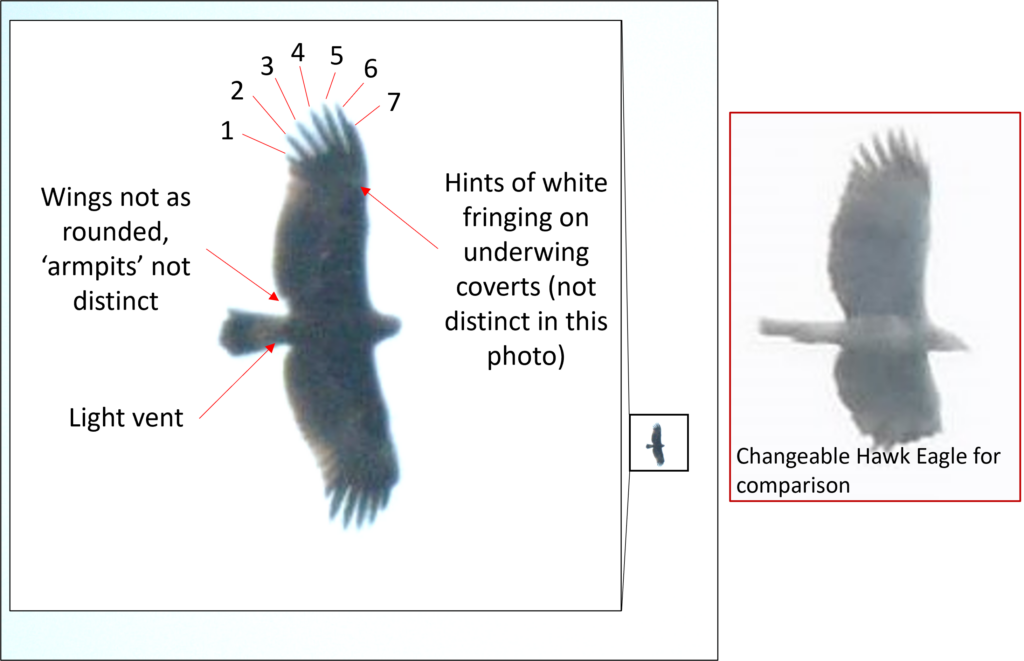
The Greater Spotted Eagle has an overall dark plumage, with broad wings ending in seven ‘fingers’. It can be told apart from the Changeable Hawk Eagle by less rounded wings, resulting in less of an ‘armpit’ and the presence of a light vent. It is also much bigger. It also has white fringing on underwing coverts, with a whitish patch at base of outer primaries. More information on this can be found on our species page.
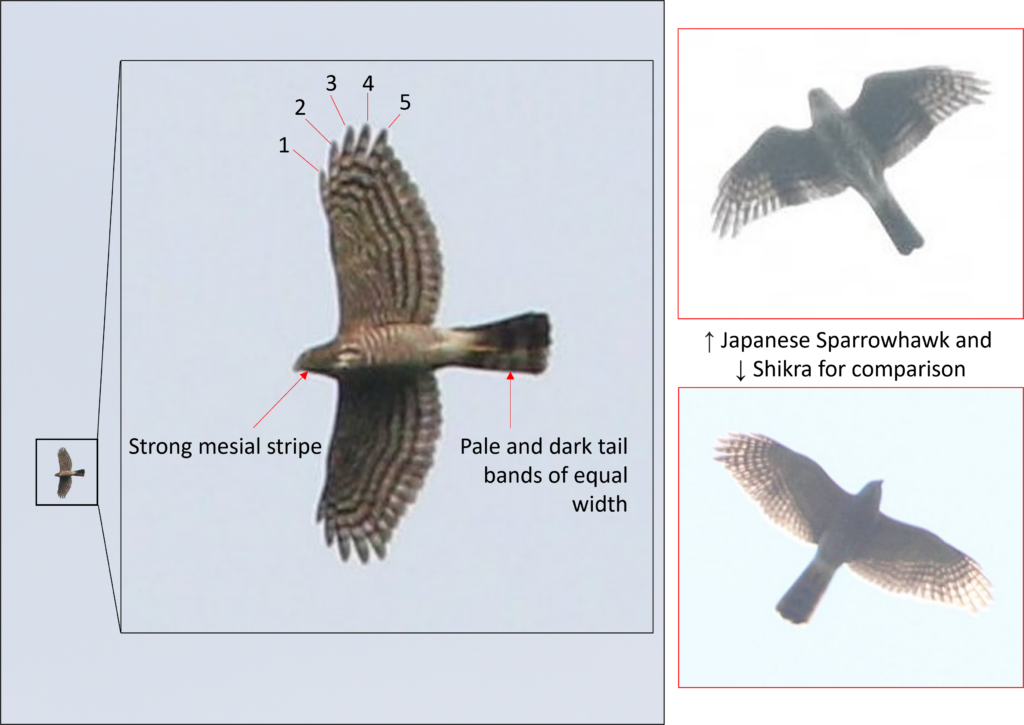
The Besra is a sparrowhawk (typically referred to by their genus name Accipiter), and is hence small and closer in size to Japanese and Chinese Sparrowhawks. Like the Japanese Sparrowhawk and Shikra (also an accipiter – a very rare bird with only two local records), it has five ‘fingers’ but differs by having a strong mesial stripe, with its tail showing alternating dark and light tail bands of equal width. The Japanese Sparrowhawk in comparison typically has wider white bands, while the Shikra can be told apart by their much longer looking tail. The Besra has only been recorded in Singapore a handful of times, making it quite the rarity.
We hope this has been useful in telling these uncommon raptors apart. As some species can be rather tricky to identify, do check in with helpful birders on social media and identification forums when in doubt!
Not to worry, we have not forgotten about the Harriers. Keep your eyes peeled for the next installment, where we will dive into identification of Harrier species that migrate through Singapore!
Acknowledgements
Thanks to the field buddies, especially Max Khoo, Low Bing Wen and Oliver Tan, for suggesting a sequel covering uncommon raptors be done up and the team for their comments on the article.
References
Billerman, S. M., Keeney, B. K., Rodewald, P. G., & Schulenberg, T. S. (Eds.). (2020). Birds of the World. Ithaca, NY, USA: Cornell Laboratory of Ornithology.
DeCandido R., Nualsri C., Siponen, M., Sutasha, K., Pierce A., Murray, J. & Round, P. D. (2014). Flight identification and plumage descriptions of six Accipiter species on southbound migration at Khao Dinsor, Chumpon province, Thailand. BirdingASIA, 21(2014), 52-62. Link
del Hoyo, J., Collar, N., Marks, J. S. & Kirwan, G. M. (2020). Eastern Buzzard (Buteo japonicus), version 1.0. In del Hoyo, J., Elliott, A., Sargatal, J., Christie, D. A., & de Juana, E. (Eds). Birds of the World. Cornell Lab of Ornithology, Ithaca, NY, USA. https://doi.org/10.2173/bow.combuz6.01
Eaton, J. A., Balen, B., Brickle, N. W. & Rheindt, F. E. (2021). Birds of the Indonesian archipelago, Greater Sundas and Wallacea. Lynx Editions.
Gill, F., Donsker, D., & Rasmussen, P. (Eds). (2021). IOC World Bird List (v11.2). Link: https://www.worldbirdnames.org/new/
Lindhom, A. & Forsten A. (2013). “Common” Buzzards of South China and South-East Asia. Caluta, 4, 1-11. Link: http://www.caluta.fi/Caluta/Caluta4.pdf
McClure C. J. W., Lepage D., Dunn L., Anderson D. L., Schulwitz S. E., Camacho L., Robinson B. W., Les Christidis, Schulenberg T. S., Iliff M. J., Rasmussen P. C. & Johnson J. (2020). Towards reconciliation of the four world bird lists: hotspots of disagreement in taxonomy of raptors. Proc. R. Soc. B, 287. Link: https://royalsocietypublishing.org/doi/pdf/10.1098/rspb.2020.0683
Robson, C. (2008). A Field Guide to the Birds of South-East Asia. New Holland Publishers.
